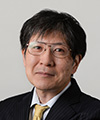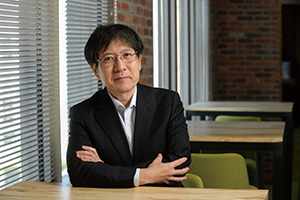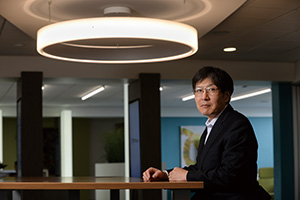 |
|
|
|
|
|
View from the Top Vol. 19, No. 11, pp. 1–5, Nov. 2021. https://doi.org/10.53829/ntr202111tp1
Try It Yourself and Pursue the TruthOverviewNTT Research focuses on cutting-edge basic research in the fields of quantum computing, cryptography, blockchain, and medical/health informatics with partners around the world. Two years after its establishment, it has won several prestigious awards, including the International Association for Cryptologic Research (IACR) Test-of-Time Award, SPIE Maiman Laser Award, and IACR Crypto 2020 Best Paper Award. The institute’s achievements also include solving the 20-year-old problem of program obfuscation. We interviewed Hideaki Ozawa, chief operations officer and chief technology officer of NTT Research, about the progress of research and the art of management. Keywords: basic research, NTT Research, Inc., R&D management Finding the seeds of new technologies—Two years have passed since NTT Research was established. Could you give us an overview of the institute and the progress of research? NTT Research was established in July 2019 in Silicon Valley, USA, to focus on basic research and advance technologies to bring positive change to human life by assembling scientists and experts around the world. It is composed of three laboratories: the Physics & Informatics Laboratories (PHI Lab), whose main research area is quantum physics, including quantum computers based on optical technology, which will form the basis of the novel technologies required in the future beyond the era of the Innovative Optical and Wireless Network (IOWN); the Cryptography & Information Security Laboratories (CIS Lab), whose main research area is information and mathematics theory, including cryptography necessary to promote the safe use of various data such as personal information; and the Medical & Health Informatics Laboratories (MEI Lab), whose main research area is medical and health information, which will be required to individualize and revolutionize healthcare services. These three laboratories aim to create a new technological direction toward business creation over the next 10 to 20 years by combining the basic technology fields that NTT’s research and development (R&D) labs have cultivated over many years in Japan with the wisdom of scientists and experts around the world. From April 2020, our 68 papers were accepted and published, and 16 patents (PHI Lab: 4; CIS Lab: 11; and MEI Lab: 1) were filed. PHI Lab aims to develop optimal systems by combining the advantages of parallel quantum computing with those of classical digital computing. It is developing the world’s most-advanced quantum computer, centered on a Coherent Ising Machine, which can operate at room temperature by using the quantum phenomenon of light. It has formed a joint research team with 14 research institutes in the US, including universities (Stanford University, Massachusetts Institute of Technology (MIT), Cornell University, Harvard University, etc.) and national research institutes such as National Aeronautics and Space Administration (NASA). In 2020, PHI Lab took up a new research theme, the “quantum approximate optimization algorithm,” and began joint research on it with MIT, the University of Chicago, and the University of Waterloo. CIS Lab researches (i) strong cryptography that can maintain security even if a quantum computer that overrides the security of existing cryptography is created, (ii) high-functionality and flexibility encryption technology that ensures the security of encrypted information, and (iii) highly secure blockchains. In the last two years, NTT has become the organization with the highest number of accepted papers at Crypto and EuroCrypt, the world’s most prestigious conferences in the field of cryptography. CIS Lab accounts for about 70% of the papers accepted as NTT. Dr. Brent Waters, who invented “attributed-based encryption,” received the Test-of-Time Award from the International Association for Cryptologic Research (IACR). Similarly, Dr. Mark Zhandry and Dr. Brent Waters were awarded the Best Paper Award at EuroCrypt 2019 and Crypto 2020, respectively. MEI Lab aims to develop physician-support systems and autonomous therapeutic systems by constructing bio digital twins, which apply Digital Twin Computing to the human body, as well as developing micro/nano devices that can be implanted in the human body. MEI Lab has started joint research with the Technical University of Munich on electrodes that can extract electrical signals from the human body and have experimentally implanted the electrodes in laboratory animals (insects, etc.) to verify their effectiveness.
—You have achieved a lot in a short period. As chief operations officer and chief technology officer, I oversee the entire staff of the laboratories, and for the past two years, I’ve been focusing on improving our basic R&D capabilities, technological capabilities of the entire group, and corporate value of the group. One of our most urgent tasks was to establish the organization in regard to, for example, recruitment of human resources and conclusion of joint-research agreements with many universities and other institutions. The directors of PHI, CIS, and MEI Labs are world-renowned and who have made significant achievements in their respective fields. By using their human networks, we have invited outstanding researchers worldwide to work in research areas that support the unique technologies that NTT has accumulated and formed research teams that collaborate with researchers in the United States and abroad. The number of researchers has grown from a dozen or so at the time of establishment to 38. Of those researchers, 35 have doctorates, and two are licensed physicians. We have strengthened diversity over the past two years by hiring an increasing number of non-Japanese. We now have 12 from North America, 2 from Europe, and 24 from Asia-Oceania, half of whom are from India, Singapore, Australia, and South Korea, and the other half are Japanese. We have also established a branch in Munich, Germany, to carry out joint research with the Technical University of Munich. We have set the following three key performance indicators (KPIs): (i) improvement of our basic R&D capabilities, (ii) improvement of the technical capabilities of the entire group, and (iii) improvement of the corporate value of the group. Regarding (i), we have set a target for the average number of papers accepted per researcher per year as one and average impact factor of each paper as 5.0 or more. Regarding (ii), we have set a target of applying for more than ten patents per year and developing human resources by taking on one to three people per year. Regarding (iii), we have set a basic-R&D-capability indicator based on an average number of citations of 6.0 or more for at least five years after the publication of a paper and holding a global R&D workshop once a year. As a result of our efforts, I believe we have met all three KPIs: (i) we have achieved a mean impact factor of 6.3, (ii) accepted more than 25 interns from universities in the US and abroad, and (iii) in September 2021, we held a two-day global R&D workshop that was a hybrid meeting of online and on-site, attracting a total of about 2000 views online and about 130 participants on-site. I believe that one of the main reasons we have been able to achieve these results is because talented researchers assemble and inspire each other centered on world-class researchers having a unifying cohesive power. However, it is not enough to simply have the world’s top-class group of researchers. It is also necessary to have researchers who support the top-class researchers in each research field. In the quantum and medical fields, we need people who can support experimental research. Therefore, we are also hiring young researchers such as those who have just completed their doctoral course. In light of these factors, I believe that we have created an almost ideal environment for basic research. From the perspective of using the results of basic research for the benefit of society, applied research is necessary; however, since NTT Research focuses on basic research, we will consider how to transfer the results of basic research to applied research.
Take a bird’s-eye view and find the excesses and deficiencies—It is said that the location of work has become no longer an issue during the coronavirus pandemic. Under such circumstances, what is the significance of NTT having research bases abroad? NTT’s business has changed dramatically over the past 20 years. Currently, NTT Group’s revenue is about 12 trillion yen, of which about 2 trillion yen is generated outside Japan as our business expands globally, mainly through mergers and acquisitions (M&As). When I was working at an NTT operating company in Japan and approached overseas companies for global business collaboration, they would ask, “Where are you doing your R&D, Japan or the US?” At that time, I realized the importance of not only taking the results of Japanese R&D overseas but also conducting R&D and turning it into business at and in the style of the location where the business would be rolled out. In this sense, I believe that expanding our global business through M&As and creating the technologies necessary for our business on a global scale is an appropriate way for NTT to grow its global business. As you said, remote work has become widespread, and it is now possible to conduct business without visiting the site. Business is fundamentally based on communication between people, and from that viewpoint, as long as seamless communication is achieved, it might not matter whether business is done face-to-face or remotely. For R&D, however, the situation is a little different from that of business. An important factor in conducting the best research is to have an environment with the best resources (i.e., people and equipment). Silicon Valley offers exactly such an environment, and it is one of the reasons that NTT Research chose to locate in Silicon Valley. Although there has been much talk about the spread of remote work in the wake of the coronavirus pandemic, researchers have been using email as well as online discussions and other activities long before the pandemic. However, research activities require experimentation and verification. Accordingly, a research base should be established where the resources for experiments and verification are located. Silicon Valley has the best resources needed for research at PHI, CIS, and MEI Labs. When we talk about the necessity of establishing overseas bases, I believe whether the location is overseas or in Japan is unimportant; instead, it is important to determine the essence of the research activity and where to conduct such activity. —Expectations concerning what NTT Research has to offer are high. Do you have any difficulties in your position as a uniter of the world’s top researchers? For me, life in the US is a good fit, and I’m happy working here. I’ve had a rather unique career in NTT’s R&D labs. I first engaged in R&D as a researcher for about nine years, then in business at an operating company for about 15 years, and recently in R&D management. When I switched from R&D to business then to R&D management, I felt that everything I experienced in my previous job was useful in my current job, and I was gradually understanding the truth of things as I gained more experience. I feel that through interaction with a variety of professions and people, I was able to recognize turning points and understand how to use experiences, and such accumulation of knowledge would lead to success. Of course, there are some failures and disappointments, but I am trying to focus on positive aspects of my experiences. From my experience, I’d say that the job of top management is to create an environment in which people can work happily, define the concept of operations, create a roadmap, and build a team by acquiring human resources. Moreover, I think the most important role of management is to look at the whole picture from a bird’s-eye view and find out the excesses and deficiencies from there. It is also important to change the way of managing the organization depending on the organization, mission, and quality of work. For example, one time, I was seconded to a subsidiary of Kadokawa Shoten Publishing Co. Ltd., whose mission was to develop and operate web services to ensure that work was carried out efficiently to meet release dates for the weekly local guide magazine and website, so a certain degree of strong management was necessary. When I was the head of NTT Media Intelligence Laboratories, however, it was important for the laboratory staff to come up with new added value on their own, so strong management was not necessary. Here at NTT Research, I don’t think strong management is necessary because too much control can reduce the originality of researchers and their ability to advance R&D. I think as long as the direction of research does not deviate significantly, I’ll only focus on the results of the research. NTT Research has been operating for only two years, so I think we still have some omissions and shortcomings in the management of the organization. I’d like to improve and revitalize our institute with a more comprehensive and bird’s-eye view of the whole picture.
Management that makes everyone involved feel confident—So management style differs completely depending on the subject, right? What matters most to you in business or management? What matters most for me is to be of service to others, and that fundamental part of my life will never change. I think that work is what humans do, and what humans plan and do to achieve what they want is work. I believe that even though our positions and roles differ, work is about producing some kind of result and having an impact on society. With that in mind, what I aim to do is to try it myself. I want to create an environment in which my colleagues can all feel confident in their work. Therefore, I’ll continue to challenge myself to do new things while making myself, team, and customers all happy through their work. To meet that challenge, I first challenge myself and show them what I can do myself to some extent then ask them to challenge themselves to go beyond that. For example, when any of my staff or teams were about to give up and say, “I can’t do this,” I’d first try to work on the problem myself and show them that they can solve it if they try. Then I’d step back and let them to work on it. —Do you have a message for researchers and engineers inside and outside the company? The first is to challenge yourself every day. There are many talented people in the world, and I want you to aim to take on challenges with them. For example, I heard that Sakichi Toyoda, the founder of Toyota Industries Corp., the predecessor of Toyota Motor Corporation, faced a lot of concerns from within the company when he decided to expand his business overseas. On hearing those concerns, he said, “Open your mind, and look at the great world outside.” I want many researchers and engineers to see the wide world. The common quality among world-class researchers is a strong spirit of inquiry. For example, I don’t think Einstein started his research on relativity because it would have a high impact factor, as we would say today, and I’ve also heard that his papers on relativity were first published in journals that didn’t attract much attention. I encourage researchers to conduct their research activities not simply to submit papers to journals with high impact factor but to investigate the essence of their research problems. I believe that what is most important in any job is to pursue the truth. Interviewee profileCareer highlightsHideaki Ozawa joined Nippon Telegraph and Telephone Corporation (NTT) in 1991. After engaging in research and practical application of multimedia processing technologies at NTT Human Interface Laboratories and Cyber Solution Laboratories, he joined NTT WEST (seconded to Walkerplus, Inc.) in 2000, where he was involved in the provision of local multimedia information. He then joined NTT Resonant Inc. in 2004, where he worked on the development and management of °»goo°… internet services including its search engine and the establishment of mobile-search business, and became head of the Search Business Division in 2011. After serving concurrently as president of NTT Resonant Technology, Inc. from 2013, he became vice president, head of NTT Media Intelligence Laboratories in 2015 and head of the Global Business Promotion Office at NTT TechnoCross Corporation in 2018. He assumed his current position in June 2019. |




